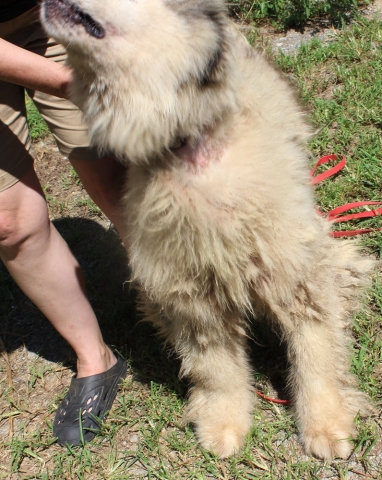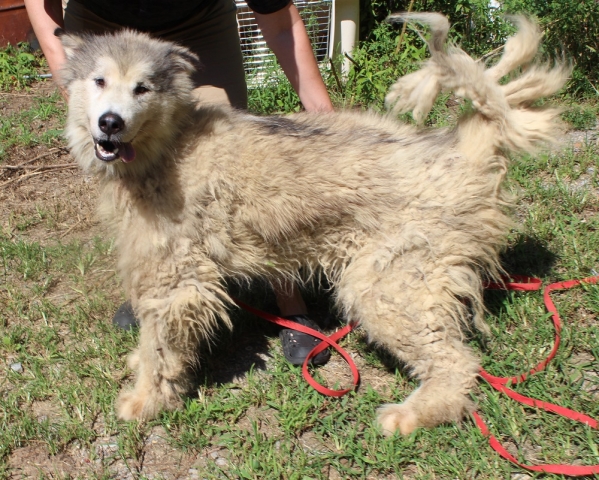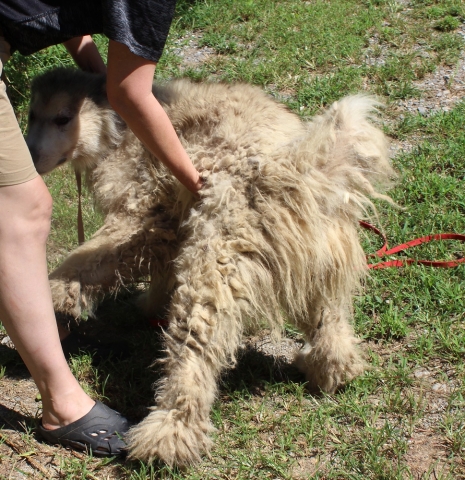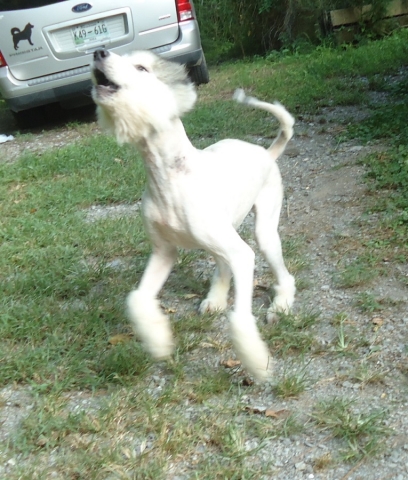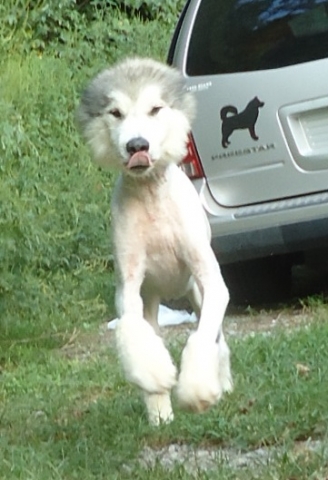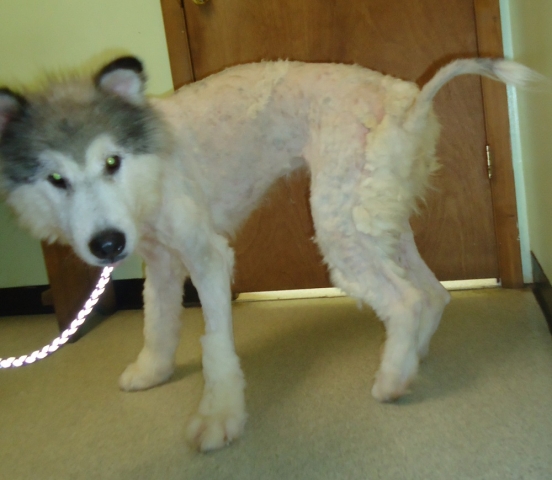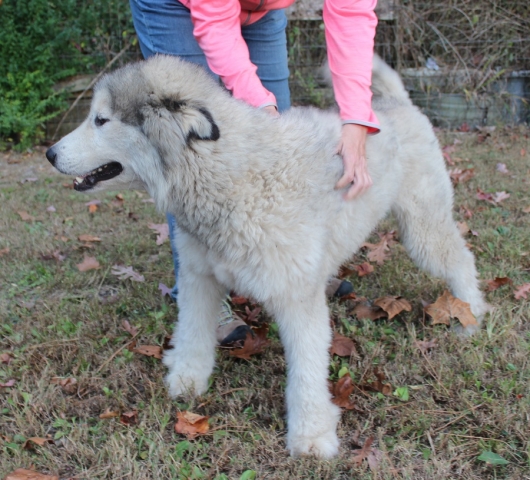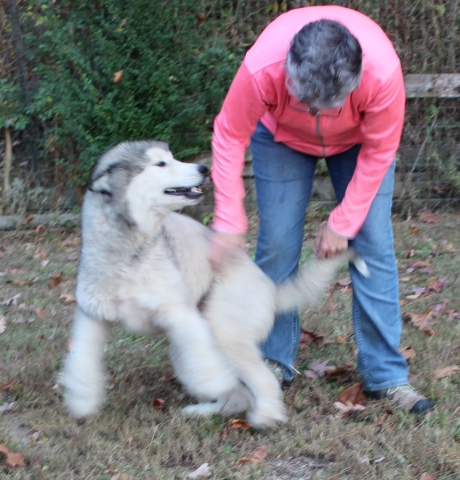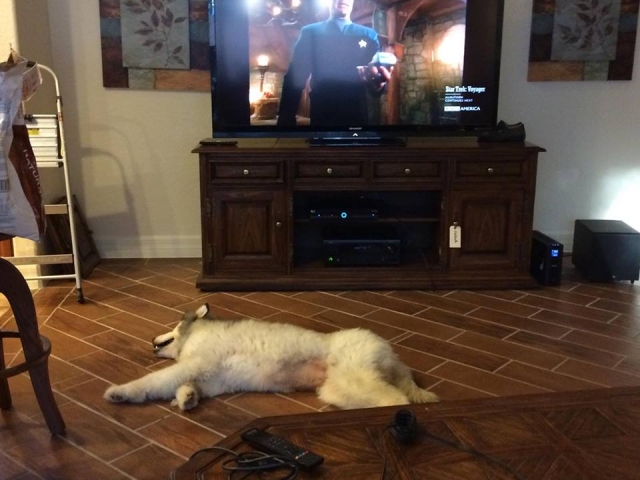Thoughts on Malamute coat genetics.
Genetic info is mostly referenced from the following website — with deep appreciation for her work: Nicole Royer’s Malamute Coat Color Genetics. Mistakes are my own.
Coat characteristics are fun genetics because you can look at the puppies and usually TELL if they are Normal (LL) or Long-coat (ll) or Normal & a Long-coat carrier (Ll). You can TELL what color they are. If you’re wrong, it’s no big deal… but you can learn a lot by playing the coat color and coat length guessing game as they grow up…
Part 1: Coat & Pigment Color
No good dog is a bad color!
In Malamutes, nose pigment (and lips, eye rims, and toe pads) is either black or brown. If it’s pink or not pigmented, it’s just incompletely colored, but it’s still black or brown. And some adults have nose pigment that fades down the middle in winter and is called Snow Nose.
[vertical-spacer]
[one-half-first]
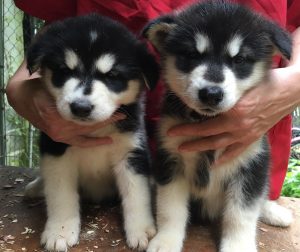
Black Pigment
[/one-half-first]
[one-half]
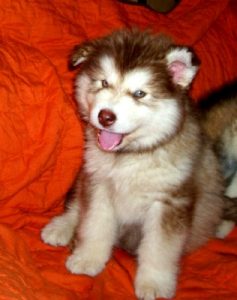
Brown Pigment
[/one-half]
[one-half-first]
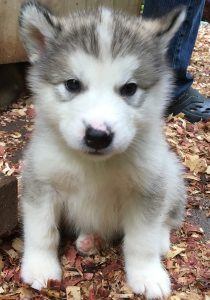
Incomplete Pigment (so far)
[/one-half-first]
[one-half]
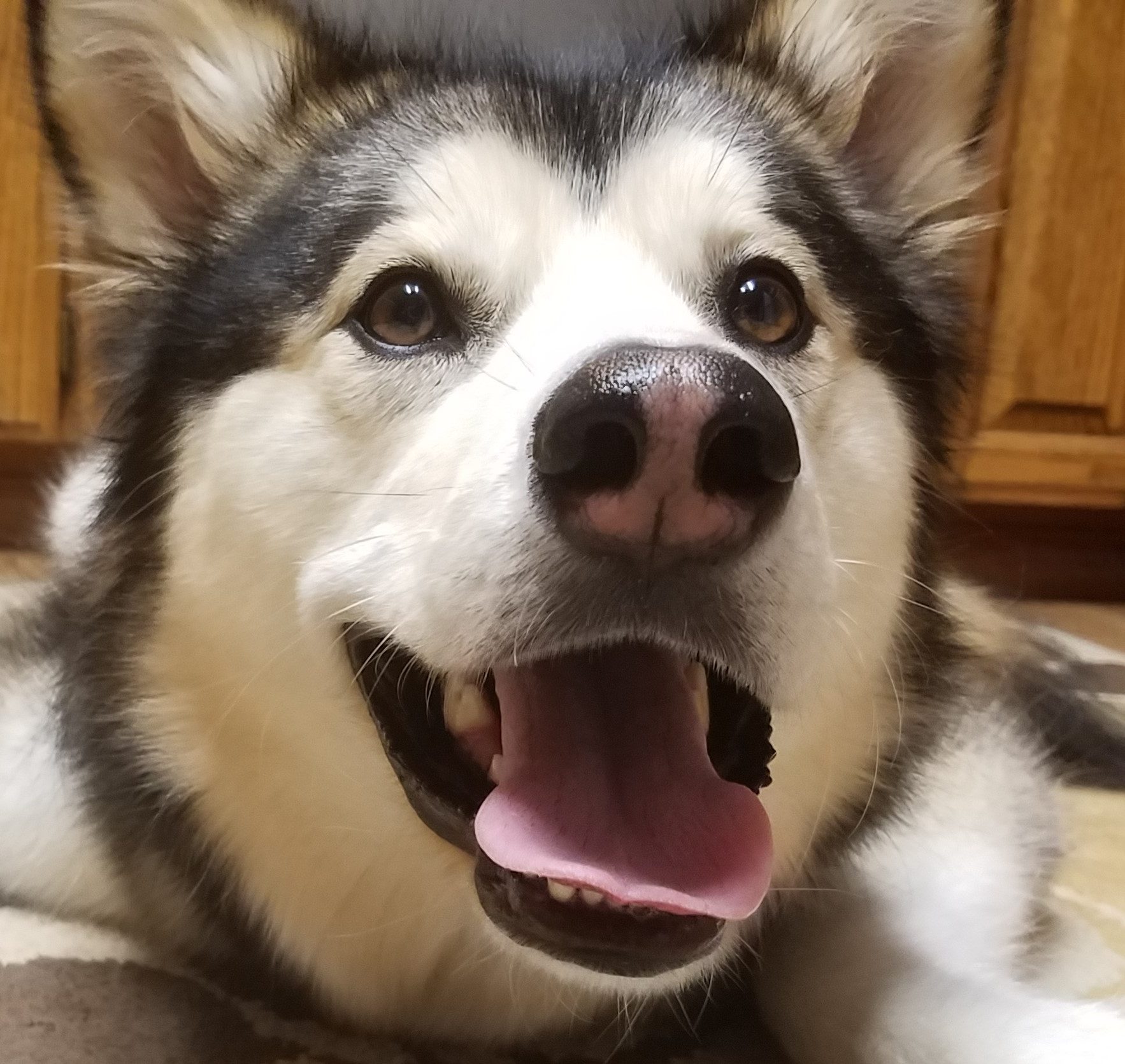
Snow Nose
[/one-half]
[vertical-spacer]
The only approved coat colors for AKC Alaskan Malamutes:
- Agouti & White
- Black & White
- Blue & White
- Gray & White
- Red & White
- Sable & White
- Seal & White
- Silver & White
- White
So if your dog has black nose pigment, he can be correctly registered as any of these colors except Red & White. If your dog has brown nose pigment, he can be correctly registered as Red & White or a White (which is not really a color, it’s a pattern that masks the true color, but skip that, it’ll make your head boggle).
These color choices are irrational. Black-pigmented black-tipped guard coats come in a natural and expected range of colors: Silver, Gray, Blue (dilute), Seal, Black, Sable, & Agouti. The same color ranges occur in brown-pigmented dogs: light red, medium red, cream (dilute), dark red, really-dark red, red sable & red agouti. But our choices are….. Red.
Sable is the undercoat color, not the guard-coat color. Sables can and do occur in both color ranges — so to be more accurate Silver Sable, Gray Sable, Blue Sable (dilute), Seal Sable, Black Sable, Agouti Sable… and the Red Sables.
It’s ridiculous to lump all sables together, all agoutis together, and all reds together when we have separated the “black-pigmented black-tipped guard coats” into individual colors. But there you are.
Therefore Wyatt, Cheers, and Maestro are registered as GRAY, AGOUTI, and SEAL. But they are also sables.
[vertical-spacer]
[one-third-first]
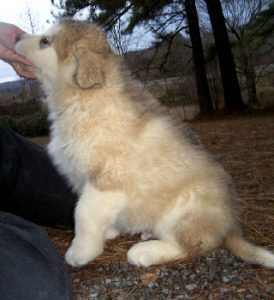
Wyatt, Gray sable (maybe Silver sable)
[/one-third-first]
[one-third]
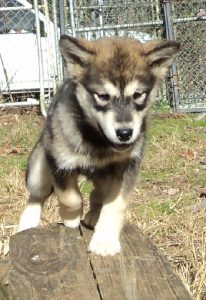
Cheers, Agouti sable
[/one-third]
[one-third]
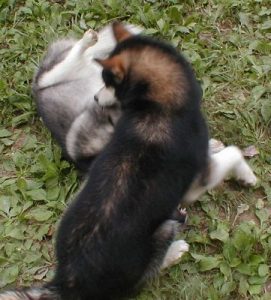
Maestro, Seal sable
[/one-third]
[vertical-spacer]
I hope it’s obvious the problems with these limited choices. If still in doubt, check out a Rainbow of Malamute Colors.
Part 2: Markings
The white Malamute is not an albino, that’s a different gene and affects nose pigment, eye pigment, and sometimes hearing. The white Malamute is a regular Malamute with a masking gene that ‘masks’ the color pattern. If bred to a Malamute that does not carry the masking gene, the white Malamute produces whatever he carries under his white pattern.
The typical Malamute “pattern” is dark on top and light on bottom (think of an orca or shark). This pattern is separate from the White Spotting Gene. A Gray with no evidence of the white spotting gene still has white on the face cheeks, above the eyes, and under the chin, in bands across his chest, lower legs, belly, & under his tail. When the white spotting gene takes action, you see EXTRA white — stars, snippets, blazes, withers spots, high white on the legs, half collars and collars, fully white chests or broken bands of color on the chest, white traveling up the side of the body, and large white tail tips.
Despite this, the AKC allows for 2 markings to be registered:
- Black Markings
- Gray Mask
Clearly this is not really helpful, when you consider the multitude of markings Malamutes normally come in. On the face alone a Malamute can have snippets, narrow blazes, wide blazes, open-faces, goggles, bars, split-bars, masks, full-masks and assymetrical masked.
These facial markings can occur on any color Malamute, but are sometimes easier to distinguish on the darker colors.
[one-half-first]
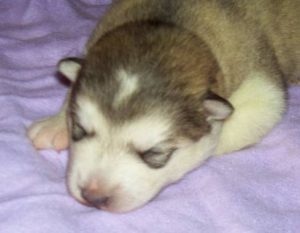
Snippet
(white on forehead)
[/one-half-first]
[one-half]
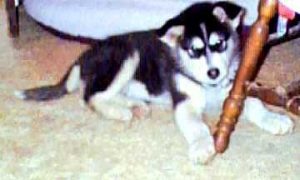
Double Bar or Narrow Blaze
(black-white-black color running up his face)
[/one-half]
[one-half-first]
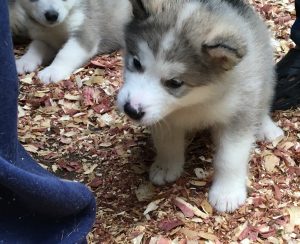
Wide Blaze
(white color running up her forehead)
[/one-half-first]
[one-half]
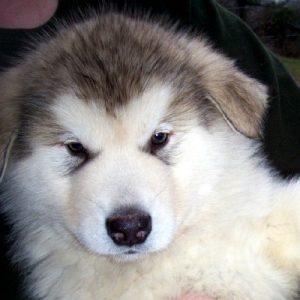
Open-faced
(more the absence of mask and distinct goggles)
[/one-half]
[one-half-first]
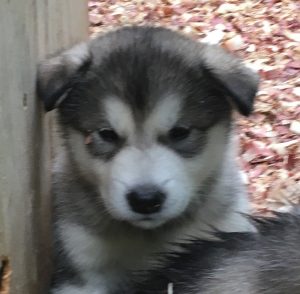
Goggles
(around the eyes, wrapping towards the nose)
[/one-half-first]
[one-half]
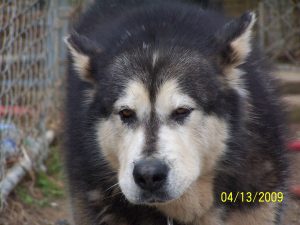
Bar down the nose
(with snippet, goggles have faded away, she’s 10yo here)
[/one-half]
[one-half-first]
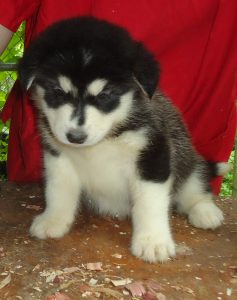
Split Bar on muzzle (with small snippet on forehead)
[/one-half-first]
[one-half]
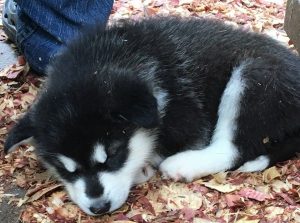
Mask
(connected goggles and bar)
[/one-half]
[one-half-first]
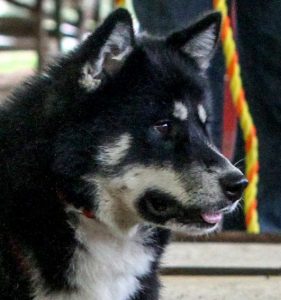
Full mask, smudgy mask smears down the face and the whites are not crisp white on this true black & white dog, also note tiny white eye spots
[/one-half-first]
[one-half]
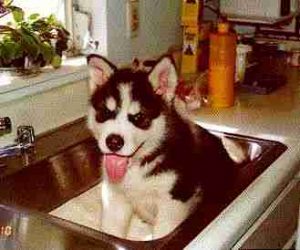
Uneven or asymmetrical mask
[/one-half]
[vertical-spacer]
These last two are some of my favorite markings, smudgy and uneven are interesting (and 2 of my favorite dogs, too). Also take into account that puppy goggles often fades off as the dog ages, but color running up the nose on top of the muzzle (the bar) generally stays for life. Small snippets visible in a short puppy coat can disappear into a normal-length adult coat. And I’ve heard of one dog who had a white streak that went up his face, down his neck, and along his spine, but it was invisible in his longer adult coat unless you looked for it (his name was Zip!)
Consider Nicole Royer’s White Spotting (there’s a Wayeh puppy sitting with an “eagle” on her chest.
Part 3: Length
AKC Alaskan Malamute Standard
“The Malamute has a thick, coarse guard coat, never long and soft. The undercoat is dense, from one to two inches in depth, oily and woolly. The coarse guard coat varies in length as does the undercoat. The coat is relatively short to medium along the sides of the body, with the length of the coat increasing around the shoulders and neck, down the back, over the rump, and in the breeching and plume. Malamutes usually have a shorter and less dense coat during the summer months. The Malamute is shown naturally. Trimming is not acceptable except to provide a clean cut appearance of feet.”
We have a lot of choices here as well. The 2 lengths discussed in the AMCA Standard are Normal and Long. But each has modifiers to make them shorter, medium, or longer. So Normal length coats can also be Normal short, Normal medium, and Normal long — not a long-coat, just a LOT of coat. Long-coats can be Long & short (I hate the language here, but there it is), Long & medium, and Long and long — we call the later yaks. And spaying a bitch often increases the length and softness of her adult coat. We haven’t developed gene tests for modifiers, only Normal (LL), Long-coat (ll), and Normal with a Long-coat recessive (Ll).
- Normal (LL) coats stand off from the body, they are stiff & harsh, and usually have very little leg coat, furnishings, or tail feathers. They are very utilitarian, weatherproof, shed out easily and are usually a breeze to keep clean because of the harshness of the coat and the natural oils in the coat. This is a correct coat, so long as the guard coat is 1-2″ longer than the undercoat — that’s the only objective reference in our Standard to coat length. When these dogs (LL) are bred to long-coats (ll) they produce carriers (Ll).
- Normal coats with the Long-coat recessive (Ll) can stand off from the body, be stiff and harsh the way they should be but generally they have a little EXTRA leg coat, a little EXTRA ruff, a little EXTRA plume in the britches and tails. They are NOT long they are BIG. And this is the coat I prefer and strive for. Most dogs at Wayeh are Ll by selection.
- Long-coats (ll) on adults do not usually stand off from the body, the hair is so long it tends to drape like a rough-coat collie. The leg feathering, britches and tails can be EXTREME. The coat texture can be either soft or harsh (harsh being correct). Both soft and harsh long-coats will require more work than the normal lengths because they tangle and mat more easily than normal-length coats. But if you don’t mind grooming and love the looks of a long-coated Malamute — and can make him an indoor dog — than they are head turners.
None of these dogs were tested for the long-coat carrier gene, but they also never produced a long-coat and have the tight, “dry” coats with no featherings at the ears or legs associated with the long-coat gene.
Normal coats (LL)
No extra frills (& have never thrown long-coats)
[vertical-spacer]
[one-third-first]
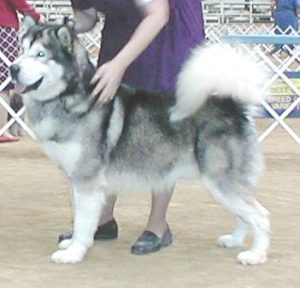
Nikko
[/one-third-first]
[one-third]
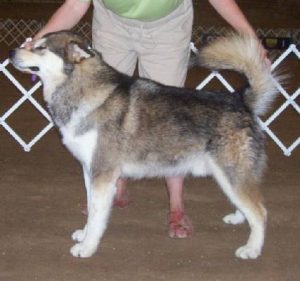
Yogi
[/one-third]
[one-third]
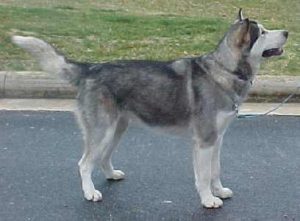
Luna
[/one-third]
[vertical-spacer]
Normal Coat with long-coat recessive (Ll)
A little more fullness to their coat and have produced all three types of coats.
[vertical-spacer]
[one-third-first]
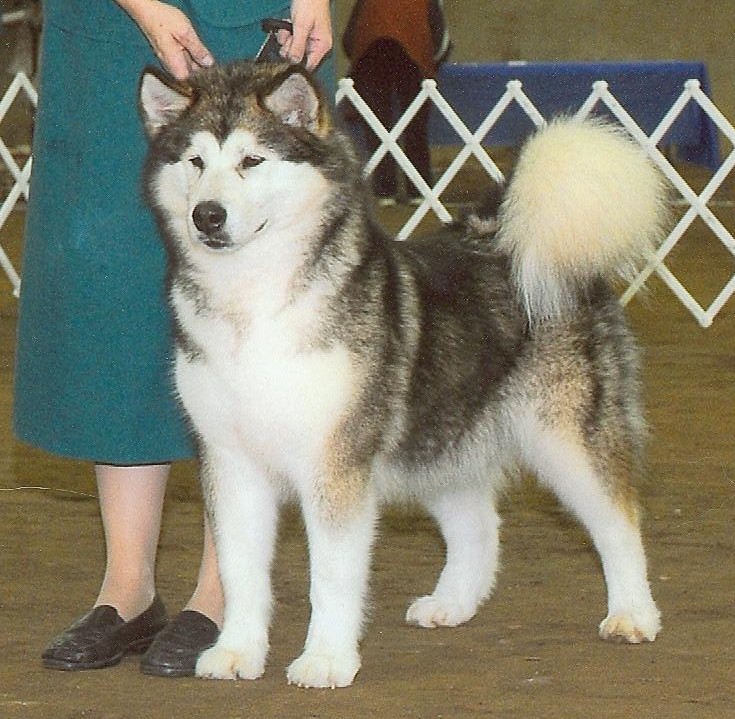
Bright
[/one-third-first]
[one-third]
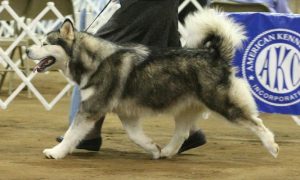
Sunny
[/one-third]
[one-third]
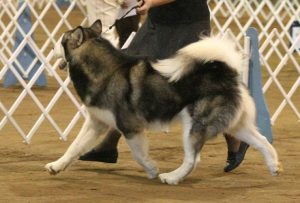
Akai
[/one-third]
[vertical-spacer]
Long-coats (ll)
[vertical-spacer]
[one-third-first]
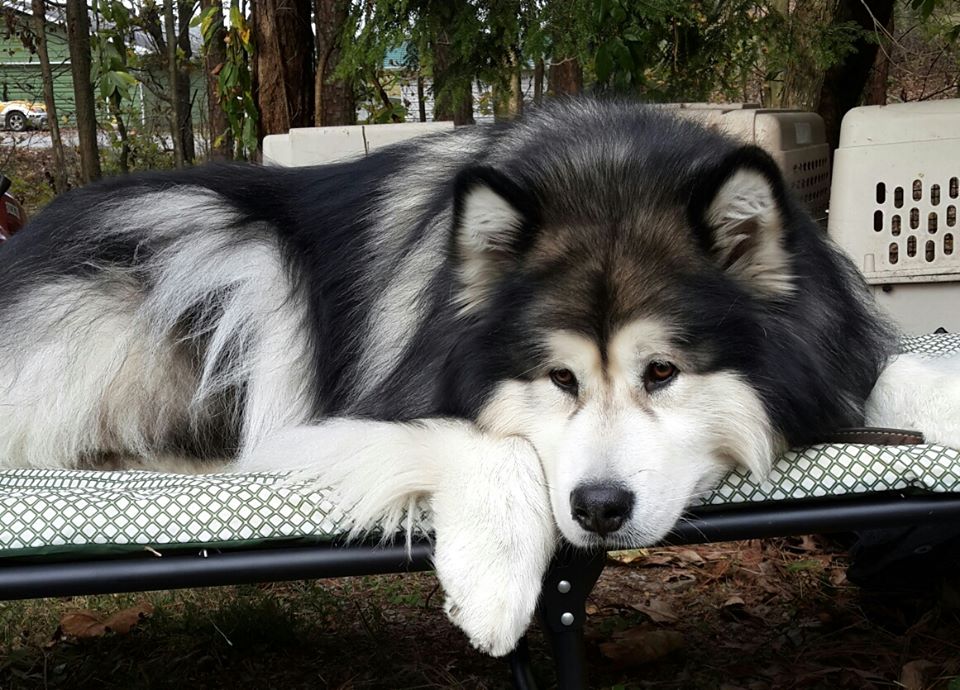
Marji
daughter of Bright (directly above)
[/one-third-first]
[one-third]
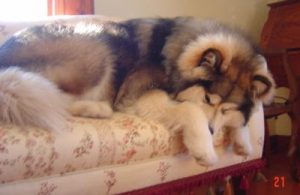
Sonny Boy
son of Sunny (directly above)
[/one-third]
[one-third]

Maverick
son of Akai (directly above)
[/one-third]
[vertical-spacer]
There are no more health problems associated with long-coats than normal coats… so long as you are willing and able to do the work to maintain all that gorgeous Fabio hair or Farrah Fawcett hair. There is something to be said for long-coats having extra big bone, extra large feet, extra broad heads and chunky muzzles, and extra sweet temperaments to go with all that extra hair.
More info on coat length genetics. More on FAQ long-coats at Wayeh.
Part 4: Texture
I’m going to repeat the quote above but add in bold and caps.
“The Malamute has a thick, coarse guard coat, NEVER LONG AND SOFT. The undercoat is dense, from one to two inches in depth, oily and woolly. The coarse guard coat varies in length as does the undercoat. The coat is relatively short to medium along the sides of the body, with the length of the coat increasing around the shoulders and neck, down the back, over the rump, and in the breeching and plume. Malamutes usually have a shorter and less dense coat during the summer months. The Malamute is shown naturally. Trimming is not acceptable except to provide a clean cut appearance of feet.”
AKC Alaskan Malamute Standard
The correct texture for a Malamute coat is thick, coarse, oily and woolly — as in a sheep’s wool. That dog gets wet, shakes off or is toweled off. and can come in the house without leaving puddles. That dog is a real trick to get soaked to the skin in a bathtub. The word ‘woolly’ has been co-opted to mean ‘long, soft coat’ in the vernacular, which it does NOT in the standard. So I’ll stop using it.
Long and soft is incorrect. But the standard doesn’t specify long and coarse, or normal and soft, or long or soft. The word AND was chosen. I don’t think that means that normal and soft is correct. But I do think too much is made of the relative length of coat vs. the texture of the cat. A normal and soft coat is in more risk in winter weather than a long and coarse coat.
And there are far too many thin-coated dogs with insufficient undercoats to handle winter, they’d shiver into pieces instead of doing the job, which is hauling freight down the winter trail.
[columns-container class=””]
[one-half-first]
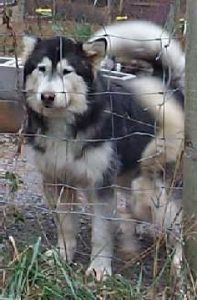
Long and soft coat
[/one-half-first]
[one-half]

Long and coarse coat
[/one-half]
[one-half-first]

Can’t tell by looking, but normal length and soft, got longer (not long) and softer after she was spayed
[/one-half-first]
[one-half]
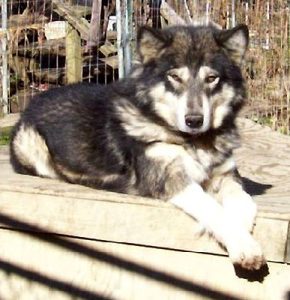
Normal and coarse, oily, woolly — the perfect weatherproof coat, nearly impossible to wet for a bath
[/one-half]
[/columns-container]
Part 5: Shaving
Shaving a Malamute is a last-ditch resort.
The Malamute coat naturally comes in a wide-variety of colors, patterns, lengths and textures. Puppy coats shed out for the adult coat. Seasonal coats shed out twice a year to throw off the previous season’s undercoat and grow in a new. A normal, coarse coat is easier for the owner to maintain, nearly maintenance-free. A long, soft coat is magnificent to look at, but all that beauty takes work. If you can’t do the work to maintain a long-coat, don’t plan on just shaving it off because that can be disastrous.
Long-coats take a LOT more maintenance than a normal coated puppy. Normal coats are self-cleaning, long-coats are anything but. Long-coats can develop skin problems if neglected because the hair “can be” so dense that air has a hard time circulating. A good groomer is a must, whether that’s you or one you hire. A forced-air power dryer for dogs is a MUST, as is a metal greyhound comb and a leave-in spray detangler. Some Long-coats have such a harsh texture that they don’t tangle, but the detangler will help separate the hairs, which removes the dead hairs and keeps a cleaner and cleaner-smelling coat, allowing better air circulation way down under that blanket of hair.
There is nothing cuter than a Long-coat puppy and nothing more magnificent than a well-maintained Long-coat adult. But if you are not up to the extra work or hiring it done, please don’t get a Long-coat.
The WORST thing you can do for them is shave them. That removes all the guard hairs and that’s the only texture in their coats — which means every burr grabs that wooly undercoat. If you shave them closer than that, then you risk sunburn and heat stroke.
Except…
In an old dog, especially one with a huge shaggy bear-like coat, even a normal but massive old-dog coat, sometimes I will shave under the throat, down the chest, between the front legs, the arm pits, the belly (leaving the long side hairs as camoflage), the abdomen, the groin, and the inner legs. These are the major heat-exchange areas, where big blood vessels are right under the skin, and the dog can belly down on a cool surface to drop his temperature, and in an emergency, you can get cool water to the skin easier and more efficiently. Generally, the groin shave was the best solution since the old dogs with the big shaggy coats would dig a cool pit and lie down in it. But this means you have to be extra vigilant watching for skin rashes, because the coat isn’t present to shield the vulnerable skin.
But if you are NOT willing to do the work and you stick a long-coat in a 10×10 mud kennel, this is what could happen.
And this could happen.
And it could be half a year before she gets to this:
Commit to the work of a Long-coat or get a dog with hair that you can live with — be fair to the puppy.
Best long-coat link ever, Nicole’s Long-coat Comparisons.
